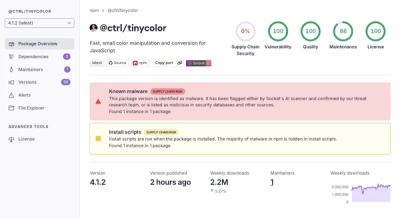What is css-tree?
The css-tree npm package is a tool for parsing and manipulating CSS. It allows users to parse CSS strings into an abstract syntax tree (AST), walk over nodes in the tree, generate CSS strings, and more. It is useful for tasks such as CSS minification, linting, and transformation.
What are css-tree's main functionalities?
Parsing CSS to AST
This feature allows you to parse a CSS string and convert it into an abstract syntax tree (AST) for further manipulation or analysis.
const csstree = require('css-tree');
const ast = csstree.parse('.example { color: red; }');
Walking the AST
This feature enables you to traverse the AST and apply functions or extract information from specific nodes.
csstree.walk(ast, function(node) {
if (node.type === 'ClassSelector') {
console.log(node.name);
}
});
Generating CSS from AST
After manipulating the AST, you can generate a CSS string from the modified AST, which can be used in stylesheets or injected into web pages.
const modifiedAST = csstree.parse('.example { color: blue; }');
const css = csstree.generate(modifiedAST);
Minifying CSS
css-tree can be used to minify CSS by parsing it with compression options and then translating the AST back to a CSS string.
const compressedCSS = csstree.translate(csstree.parse('.example { color: red; }', { compress: true }));
Other packages similar to css-tree
postcss
PostCSS is a tool for transforming CSS with JavaScript plugins. It can do similar tasks as css-tree, such as parsing, walking the AST, and generating CSS. PostCSS is plugin-based, which makes it more extensible and allows for a wide range of transformations.
sass
Sass is a preprocessor scripting language that is interpreted or compiled into CSS. It offers more syntactic features compared to css-tree, such as variables, nesting, and mixins, but it is not primarily focused on parsing and manipulating existing CSS.
less
Less is another CSS pre-processor, similar to Sass, that extends the capabilities of CSS with dynamic behavior such as variables, mixins, operations, and functions. Less and css-tree serve different purposes, with Less focusing on writing CSS in a more functional way and css-tree on parsing and manipulation.
clean-css
clean-css is a fast and efficient CSS optimizer for Node.js and the browser. It focuses on minification, which is one of the features of css-tree, but does not provide a general-purpose CSS parsing and manipulation API.

CSSTree





The set of tools for working with CSS, including fast detailed parser (string->AST), walkers, generators (AST->string) and even lexer (validation and matching) based on knowledge of spec and browser implementations (see schema for details). The main goal to be efficient and W3C spec complient, with focus on analyzing and source-to-source processing.
Work in progress. The project in alpha stage since some parts need further experiments, AST format and API are subjects to change. However it's stable enough and used by packages like CSSO (CSS minifier) in production.
Docs and tools:
Related projects:
Install
> npm install css-tree
Usage
var csstree = require('css-tree');
var ast = csstree.parse('.example { world: "!" }');
csstree.walk(ast, function(node) {
if (node.type === 'ClassSelector' && node.name === 'example') {
node.name = 'hello';
}
});
console.log(csstree.translate(ast));
Top level API

License
MIT
Syntax matching uses mdn/data by Mozilla Contributors







